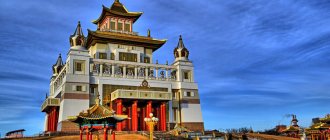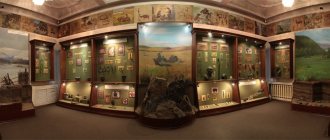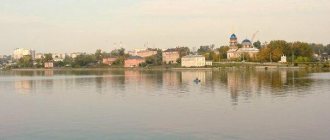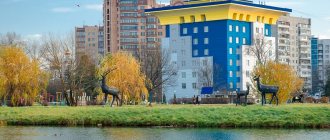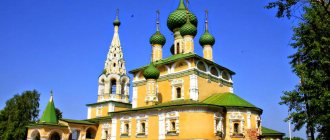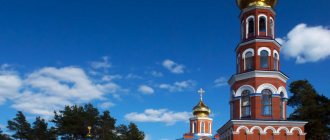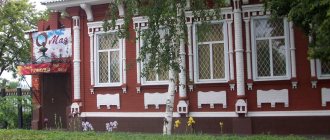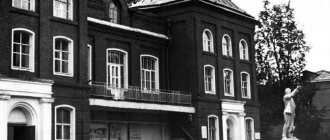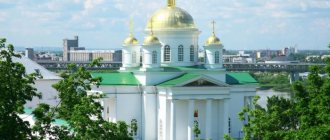We got to Elista through Volgograd late at night. But even in the dark, the city center managed to amaze us with its color. In the morning, in the sunlight, everything turned out to be much more colorful.
Let us note right away that the population of Kalmykia is three times less than in Buryatia. Of the 300 thousand inhabitants, about 100 thousand live in Elista. Therefore, the city is small, compact and incredibly cozy.
First of all, the discrepancy with the name is striking. “Elst” translated from Kalmyk means “sandy”. The town was one at its founding, but now it has more greenery than many southern cities. Siberians were especially impressed by the roses blooming in October on the streets, walnut trees in the courtyards, and thuja, which grows here as an indoor tree in pots.
Elista is a good two hundred years younger than Ulan-Ude. The city is only 153 years old. In addition, during the Second World War it was occupied by the Nazis for five months. Let's add to this the deportation of Kalmyks and the liquidation of the Kalmyk Autonomous Soviet Socialist Republic, which was restored only in 1957.
The Kalmyks themselves say that their capital would be no different from other cities with Soviet architecture if not for the first president of the republic. Under Kirsan Ilyumzhinov, Elista acquired a Buddhist flavor, for which almost everyone who drives on federal roads to Volgograd, Makhachkala, and Astrakhan comes here. We especially emphasize that in Elista during the same years the Kazan Cathedral, the Worship Cross and the temple-chapel of St. Sergius of Radonezh were built. But tourists and travelers come to Elista in order to see something that you cannot find in the west of Russia.
Description of Elista
Elista is a small Russian city in the south of Russia, the capital of Kalmykia. The settlement is located in the valley of the Elista River, which divides the city into the northern (large) and southern parts. The total area of the city exceeds 92 km2, the population is more than 103 thousand people. Elista is a multi-religious city (Buddhists, Orthodox, Muslims, Catholics, etc. live here).
Elista is located in the western part of Kalmykia, near the Rostov region and the Stavropol Territory
Brief history of the city
The history of Elista as a city began in 1845. Emperor Nicholas I ordered that the steppes around the Elista River be planted with forests. There was a need for labor, which required residential buildings. Then scientists, led by Kostenkov, chose 15 suitable places, among which was the territory of modern Elista. The village belonged to the Krestovskaya volost of the Astrakhan province, and then the settlement became the center of the Elista volost. Before the establishment of Soviet power, the administrative affiliation of Elista changed 2 more times (in 1907 and 1912).
In 1920, the Autonomous Region of the Kalmyk People was created. In 1925, Elista became a regional center. During the Great Patriotic War, Elista was occupied by the Nazis, and when the city was liberated on December 31, 1942, the retreating German troops burned the city almost to the ground. Since 1944, Kalmyk autonomy began to be abolished. The settlement was named Stepny, and it became the center of the Stepnovsky district. Elista again became the center of the republic in 1957.
How to get to Elista
You can get to Elista in several ways:
- By plane from Moscow, Sochi, Rostov-on-Don, St. Petersburg, Gisenyi, Kigali, Khamis Mushait, Jeddah, etc.
- By train from the nearest cities - Salsk, Proletarsk, Zimovniki, Kotelnikov.
- By bus from Moscow, St. Petersburg, Volgograd, Rostov-on-Don, Stavropol, Krasnodar, Gelendzhik and Anapa.
- By personal car or taxi via Rostov-on-Don, Volgograd or Astrakhan.
It is convenient to get to Elista by bus or car through major southern cities
Reserve - flora and fauna
On an area of 40 thousand square meters, swans and herons, gray mallards and black kites nest and stop during flight. The park is home to the white-tailed eagle, which has long been listed in the Red Book.
Carp and pike swim to spawn in lowlands that are flooded during high water, and silver carp and pike perch gather. The park is home to wild boars and wolves, foxes and hares, raccoon dogs, stoats and weasels.
Among the lifeless Kalmyk steppe there is a real forest of poplars where you can eat blackberries. At the top of the park there are fields covered with wheatgrass. Found here:
- bloodroot;
- licorice;
- elecampane;
- sedge.
In order for tourists to get acquainted with the inhabitants of wild nature and its riches, exciting excursions are organized in the reserve and festivals are held.
Sights of Elista
Elista has many architectural, historical and cultural attractions. Some of them are of particular interest to tourists.
City architecture
The architectural landmarks of the city include buildings erected at the end of the 20th and beginning of the 21st centuries. These are mainly Buddhist and Orthodox religious buildings.
Golden Abode of Buddha Shakyamuni
The Golden Abode of Buddha Shakyamuni is a Buddhist temple of Kalmykia (khurul) and the main attraction of Elista. There was once a reinforced concrete factory here, but in 2004 it was decided to build a temple in the Buddhist style. The idea of construction was blessed by the Dalai Lama XIV. The project was compiled by S. Kurneeva, L. Amninova and V. Gilandikova. The height of the building is 56 meters. The interior was painted by 9 artists.
Inside the temple there is a golden statue of Shakyamuni Buddha (designed by V. Vaskin) 12 meters high. The outside of the building is surrounded by 108 stupas and 17 pagodas. Each pagoda has statues of famous Buddhist teachers and kyurdes with prayers. And at the entrance to the temple there is a statue of the “White Elder” (Tsagan Aav). This is a pagan Kalmyk god. And here you can see a fountain, columns and sculptures in the form of lions. In addition, tourists can go to the souvenir shop and buy souvenirs for family and friends. Lovers of cultural leisure can visit the temple library with a reading room.
Information for tourists:
- address: intersection of Lenin and Ilyumzhinov streets (Yuri Klykov Street, 63);
- official website: https://khurul.ru;
- opening hours: from 8:00 to 20:00;
- the entrance is free.
The Golden Abode of Buddha Shakyamuni is visited annually by thousands of tourists and believers
Golden Gate
The Golden Gate in Elista is a monument of Buddhist architecture, erected in 1998. The object is an arch with columns and a golden roof. The height of the arch is 15 meters. The structure symbolizes a threshold, by crossing which a person can be cleansed. The author of the project is architect, civil engineer V. S. Shankhaev. The gate is decorated with 28 cult and historical drawings (author - N. Borisov).
My mother's friend is from Kalmykia. Sometime during Soviet times she moved to Penza, but she still had many relatives and acquaintances there. She said that local residents already have a tradition associated with this gate. It is believed that if the newlyweds take a photo at the Golden Gate, their family life will be happy. There are also bells under the arch, and if they ring, your wish will come true.
Information for tourists:
- address: Lenin street;
- Conveniently accessible by minibus No. 7 from the city center;
- exact coordinates: N46 18.462 E44 16.068;
- You can explore the attraction for free and at any time.
The Golden Gate is the most recognizable and popular symbol of Elista
Kazan Cathedral
The Kazan Cathedral is a Christian church built in 1996. The architectural style is Byzantine with Baroque elements. Upon completion of construction, Patriarch Alexy II presented the cathedral with the icon of the Kazan Mother of God and the Blachernae icon of the Mother of God. Throughout the republic, the day of the Kazan Cathedral (November 4) is celebrated annually. The cathedral, the Church of the Exaltation of the Cross and 1 administrative building belong to the temple complex of the diocese.
The cathedral houses a capsule with sacred Jerusalem soil. But in addition to the capsule and priceless icons, new religious values are brought to the temple every year - particles of relics and new icons. Around the cathedral there is a square of Sergius of Radonezh with a monument to the northern monk. Both the square and the monument were installed at the expense of the townspeople.
Information for tourists:
- address: Sergius Radonezhsky Street, 97 (exact coordinates: 46°18'31″N 44°13'53″E);
- official website of the diocese: https://blagovest-elista.ru;
- Opening hours: daily, around the clock (services at 7:30 and 16:00);
- the entrance is free.
In the cathedral, believers can pray and kneel before the holy relics of Nicholas the Wonderworker, Innocent, and Apostle Timothy
Stupa of Enlightenment
The Stupa of Enlightenment is a religious building, inside which Buddhist relics are kept. The Stupa of Enlightenment in Elista is one of the many stupas symbolizing nature and wisdom, victory over difficulties and the revelation of the abilities of the mind. The Elista stupa was built in 1999, the initiators were V. Gilyandikov and V. Kosovsky. The sponsors of the construction were Ole Nydahl and Shamar Rinpoche (lamas). And the interior is made by Denzong Norbu (Tibetan artist).
The object is considered the highest in the European part of Russia (11 meters). It was called "Monlam Tamched Drupa". The uniqueness of the structure is that inside the architectural monument there is a drum that needs to be turned. At each revolution of the drum, a special metal bar touches the bell, and it begins to ring. The fact is that according to the Buddhist religion, deities understand people’s prayers only in the Tibetan language - it is in this language that the mantras located inside the drum are written. And inside the stupa there is a statue of the two-armed Mahakala Bernagchen (this is the Buddhist protector of all life on Earth).
Information for tourists:
- address: Ostap Bender Avenue, 7 “A”;
- exact coordinates: 46°18′03″N 44°18′03″E;
- The stupa can be visited at any time and for free.
Guests of Elista always enjoy visiting its sights, and the Stupa of Enlightenment makes an impression on the souls and minds of people, regardless of race and religion
Temple-chapel of St. Sergius of Radonezh
The Temple of St. Sergius of Radonezh is a functioning church-chapel, built in 2005. The construction of the temple lasted 8 years, the project architect was B. Moshuldaev. The chapel was built for the 60th anniversary of the Victory over Nazi Germany and the 10th anniversary of the formation of the Kalmyk diocese. The architectural style of the building is close to classical medieval. The temple-chapel is part of the Kazan Cathedral of Elista.
The relics of the martyr Thaddeus rest in the temple; the inside walls of the chapel are painted with the names of 44 thousand Kalmyk soldiers who died between 1812 and the Chechen campaign. Next to the temple there is a worship cross, which was installed in 2000. There is also a church shop where you can buy religious literature, incense, crosses, etc.
Information for tourists:
- address: Seventh microdistrict;
- official website: https://xram-chasovnya-sergiya-radonezhskogo;
- the schedule of services is on the official website;
- the entrance is free.
Guests coming to Elista, especially Orthodox Christians, while visiting its sights, always linger near the temple-chapel of St. Sergius of Radonezh, paying tribute to the memory of this saint
Church of St. George the Victorious
The Church of St. George the Victorious is a registered Orthodox church-chapel of the Kazan Cathedral. This is a wooden church, the style is cross-domed. The standard design of the temple was developed in Vologda and assembled in Elista (1998). The building seems small, but up to 100 parishioners can fit inside at a time. The construction initiative belonged to E. Baturina (wife of ex-mayor Yu. M. Luzhkov). She also became a sponsor of the construction. The date of construction was timed to coincide with the 33rd World Chess Olympiad.
Almost every tourist who visits Elista comes to this temple. At different times, Chuck Norris, Sofia Rotaru, Elena Baturina, Steven Seagal, etc. visited here.
Tourist information
- address: Ostap Bender Avenue;
- exact coordinates: 46°17'50″N 44°18'04″E;
- You can visit the temple at any time and for free.
On the outside of the chapel wall there is a memorial plaque on which it is written that the church-chapel of the Great Martyr George the Victorious is under the care of the Association of Veterans of Local Wars
Cultural entertainment in Elista
The city's cultural attractions include the national theater, library and museums.
National Drama Theater
The National Drama Theater of Kalmykia is named after the writer and playwright Baatra Basangov. It was built in 1936. The first plays were staged based on the works of Shakespeare, Moliere, Ostrovsky and Gogol. During the Great Patriotic War, some of the artists went to the front, and the rest were mobilized for labor work. During the deportation, Kalmyk actors were exiled to the Krasnoyarsk Territory. The theater's curtains were reopened in 1959.
Most of the repertoire is based on folk traditions, folklore and Kalmyk culture. Here you can see performances based on the works of famous folk writers: Basangov, Balakaev, Sangadzhieva, etc. In addition to performances for adults, performances for children are held here. Sometimes the institution's posters advertise puppet shows.
- address: Aksena Suseeva street, 21;
- official website: https://kalmteatr.ru;
- Opening hours: Tuesday to Sunday (11:00 to 18:00);
- Ticket prices depend on the production.
Today the National Theater operates under the leadership of Honored Worker of Culture of the Republic G. B. Shurayeva and Honored Artist of Russia and Kalmykia B. N. Mandzhiev
National Library of Kalmykia
The National Kalmyk Library was opened in 1958. It is a major cultural, library, information and educational center. The library changed its name several times (Republican Scientific Library, Library named after A.M. Amur-Sanan, etc.). The national book depository was named in 1992. The library has a branch - the children's library named after N. Ochirov (since 2006).
The institution's collection includes about 800 thousand different publications. In addition to printed items, there are also electronic ones - more than 57 thousand records. Educational and cultural events (conferences, presentations, literary evenings, exhibitions, etc.) are regularly held here. At the entrance to the building there is a sculptural composition installed in honor of Amur-Sanan.
Information for tourists:
- library coordinates: 46°18′13″N 44°16′21″E;
- official website: https://kalmnlib.ru;
- Opening hours: Tuesday to Sunday (9:00 to 19:00);
- the entrance is free.
In 2010, the main library building was reconstructed (after renovation, an information and educational center for children and youth was added to the building)
House-museum of the poet Kugultinov
The Kugultinov House is a museum dedicated to the life and work of David Nikitich Kugultinov. This is the only people's poet of the republic who became famous throughout Russia. Actually, Kugultinov was born in the Yashalta region of Kalmykia (Esto-Altai village), but in 1931 the poet’s family was exiled to the Altai Territory. The poet wrote his first work at the age of 12.
The two-story house has several rooms with a restored interior, but you cannot get inside the museum. Tourists come here to inspect the house from the outside, as well as the garden, which also has a lot of interesting things. There are sandstone sculptures here. They were erected for the International Symposium “The World of David Kugultinov” (1998). Near each sculpture there is a plaque with the title of the work, philosophy and name of the author.
Information for tourists:
- address: Suseeva street, 23;
- It’s convenient to get there by buses No. 7, 10, 15, 21, 23 (stop “MVD”);
- exact coordinates: 46°18'15″N, 44°15'45″E;
- You can explore the attraction for free and at any time.
Elista residents are reverent about the past of the city, people and republic, so guests of the city have the opportunity to get acquainted with it through such attractions as the House-Museum of the poet D. N. Kugultinov
Historical monuments of the city
The main historical attractions include monuments erected in honor of famous political and artistic figures.
Monument to Oka Gorodovikov
The Oka Gorodovikov Monument (“Oka Gorodovikov on Horseback”) is a monument dedicated to the hero of the Soviet Union. It was installed in November 1976. The monument was made at the Mytishchi plant, and the authors of the project were N. A. Sandzhiev, Lev and Mark Roberman. Architect - Vasily Tyurbeevich Nimgirov. This monument is the largest monument in Elista, and it is included in the list of cultural heritage sites of the republic.
When I come across the name of a hero about whom I know little, I turn to Thomas, my friend, the historian. He told several interesting facts about Gorodovikov. Firstly, Oka Ivanovich was born in the Rostov region, and died in Moscow (buried at the Novodevichy cemetery). Elista residents are proud of Gorodovikov because he was a Kalmyk Cossack. Secondly, he took part in the battles of the First World War and the Civil War, as well as in the Great Patriotic War. Under the command of Gorodovikov, cavalry raids of the famous Battle of Stalingrad were carried out. And thirdly, Oka Ivanovich has many awards, including a rare, foreign one - the Order of the Red Banner.
Information for tourists:
- address: Gorodovikov Square;
- exact coordinates: 46°19′09″N 44°16′42″E;
- You can view the monument at any time.
Timofey Bimbeev, Chairman of the Board of the Kalmyk Union of Writers, first spoke about the construction of a monument to the Hero of the Soviet Union Oka Gorodovikov in Elista in 1969 at the congress of writers of Kalmykia.
Monument to Pushkin
The monument to A. S. Pushkin in Elista is part of the architectural and sculptural ensemble, installed in Pushkin Square (1999). The author of the project is the Kalmyk artist N. Eledzhiev (for this monument the author was awarded the Pushkin medal). The monument is surrounded by bars, on which there are bas-reliefs with excerpts from the works of the great Russian poet. Around the monument there are flower beds, a swimming pool and a fountain.
Usually, monuments to famous writers are erected if he was somehow connected with the city. An art historian I know told me that Alexander Sergeevich Pushkin, it turns out, was interested in the history of the different peoples of Russia. So he spoke about the Kalmyks with special warmth, calling them peaceful and nomadic.
Information for tourists:
- address: Pushkin Square (next to the Rodina cinema);
- exact coordinates: 46°18'22″N 44°16'10″E;
- You can explore the attraction for free and at any time.
There are always a lot of people in Pushkin Square, including local youth, who also love and know the poetry of Alexander Sergeevich from an early age
"Golden Horseman"
The “Golden Horseman” monument is dedicated to the hero of the folk epic “Dzhangara”. It was erected in 2007. The total height of the sculpture is 23 meters. The project was completed by Rostov sculptor Nikolai Mozhaev.
The “Golden Horseman” is a symbol of the Kalmyk people. Dzhangar, riding on his horse Aranzal, protects the city from enemies and reminds the Elistinians of the fabulous country of Bumba, where there are no misfortunes.
Information for tourists:
- the monument is located at the intersection of Dzhangar and Budyonny streets (1st microdistrict);
- exact coordinates: 46°19'5″N 44°15'29″E;
- You can explore the attraction at any time and for free.
As conceived by the architects, the “Golden Horseman” soars in the sky, guarding the steppe pearl of Elista and its inhabitants, holding a banner in his right hand and a Mongolian bow in his left
Memorial complex "Exodus and Return"
The memorial complex “Exodus and Return” (Monument End and Return) was erected in memory of the deported Kalmyks who spent 13 years in exile. The ensemble, consisting of the main sculptural group, a trailer and a memorial plaque, was installed in 1996. Architect - S. Kurneev, sculptor - E. Neizvestny. The bronze sculpture, which is installed on top of the mound, was made in New York.
The bronze monument includes many small symbolic details: swords, bayonets, an embryo, footprints, a lamb crying over a defeated child. A herd of horses and a horse's head mean strength and the passage of time. There are also cult symbols here - the figure of Buddha, the lotus flower, which symbolizes return, etc.
Information for tourists:
- address: 8th microdistrict, Khrushchev street;
- exact coordinates: 46°18′02″N 44°18′53″E;
- You can explore the attraction for free and at any time.
Every year on December 28, a day of remembrance for the victims of the deportation of Kalmyks is held near the monument.
Architecture and monuments of Elista
Among all the interesting things that tourists can see in Elista, it is worth highlighting the colorful monuments, of which there are quite a few in the city. Connoisseurs of elegant architecture will also not be left out.
Monument to Ubashi Khan
- Address: st. Lenin. Transport stop "Pharmacy".
Modern historians have different assessments of Ubashi’s activities as the supreme ruler of the Kalmyk Khanate. Some consider him a traitor, who carried away most of the uluses to Dzungaria. Others note the merits of the khan, who participated with the army in the Russian-Turkish war of 1668–74. However, everyone agrees that he was definitely an extraordinary person. The Ubashi monument appeared in Elista in the fall of 2012. The bronze statue of the khan, dressed in armor and proudly sitting in the saddle of a horse, is placed on a carved pedestal of white stone 3.4 m high.
National Theater building
- Address: st. Suseeva, 21. Transport stop "Hotel".
The magnificent building, which houses the Republican National Theater, is one of the architectural highlights of Elista. It attracts attention at first sight with its colorful exterior. Three entrance portals on the front side are located outside the main volume. The main one has the shape of a semicircle and rests on massive columns. The cornice of the mansion is decorated with figured attics, and the pediment above the central entrance is decorated with colorful high reliefs. The facade is decorated with tinted glass and polished granite.
Monument to Ostap Bender
- Address: O. Bender Avenue. Transport stop "October Cinema".
The sculptural embodiment of the most popular literary character - an ideological fighter for banknotes and an adventurer tireless in invention - appeared in Elista in 1999. In general, the great schemer is treated here with special love. Here a cafe, a shop and even an avenue are named in his honor. It is at the beginning of this highway that the monument was erected. The bronze statue of the “international grandmaster”, intently examining a chess knight, is surrounded by 12 chairs with neat tables. Sitting down at one of them with a cup of coffee, it is surprisingly pleasant to contemplate the image of an extremely charming descendant of the Janissaries.
Fountain "Three Lotuses"
- Address: Lenin Square. Transport stop "KGU".
A true decoration of Lenin Square and a popular place for dates is the wonderful fountain, opened in 2006. The unique composition consists of a bowl lined with polished granite and aristocratic marble, as well as an original sculptural group. Three lotuses seem to sprout from the center of the pool, at the foot of which geysers spew water. The stems and leaves of the plants are made of stainless steel, and the opened inflorescences are covered with gold. In the evening, when the music turns on and the fountain’s illumination diodes light up, a real extravaganza begins here.
Monument to A.S. Pushkin
- Address: Pushkinsky Square. Transport stop "KGU".
The work of the great Russian poet, who was praised in his brilliant works by almost all the peoples of the Russian Empire, is appreciated in Kalmykia. In 1999, in the center of a well-kept square named after the classic of world literature, a monumental composition was inaugurated. In front of the proscenium, delimited by a metal lattice with high reliefs created based on the immortal works of Pushkin, there is a cube made of black granite. Above it rises a sculpture of the poet, cast from stainless steel. The composition is completed by cast iron lanterns in retro style and a fountain. Jets of water into its small bowl erupt from a nozzle decorated to resemble an open lotus flower.
Seasonal attractions
The capital of Kalmykia has a temperate and continental climate. The air here is dry, since the Caspian Sea has virtually no effect on the local climate. After Astrakhan, Elista is considered the second driest city in Russia. Because of this feature, Kalmykia is a steppe republic. Winters here are short, there is little snow (the maximum level of snow cover is 17 cm), so you can come to Elista for the winter holidays. Among the seasonal attractions is Kolonsky Pond.
Kolonsky Pond
Kolonsky Pond is the only artificial reservoir in Elista suitable for swimming. It was created at the beginning of the 20th century, and it received its name thanks to the labor colony that used to be located here. Once upon a time, melons were grown on the shore of the pond, and on the reservoir itself there was a fishing artel. In 2009, the reservoir was cleaned and the pool was deepened, but it has been considered suitable for swimming since 2011.
In fact, the pond became popular among local residents due to an interesting fact. Several years ago, local fishermen caught a fish with two rows of teeth. We managed to establish that it was a piranha. Many theories immediately arose: frightening, mystical and associated with legends. Later it became clear that the fish was bought at the local market. Buddhist ministers Elista confirmed that there is such a ritual: in order to get rid of troubles, you need to release the unfortunate animal into the wild. The toothy find did not scare beachgoers, but one mystery is still not solved: where did the second fish go, because 2 individuals were sold.
Information for tourists:
- address: Budyonny street, 9 “A”;
- exact coordinates: 46°19′22″N 44°15′54″E;
- the opening of the swimming season may differ in different years (usually the first ten days of June);
- visiting the site is free.
Video: swimming on Kolonsky Pond
April miracle
Kalmykia is not only the Golden Abode, unique monuments of Buddhist culture, the valley of lotuses, legends about the Oirot tribe, but also the amazing flowering of more than a hundred species of tulips that grow without human intervention in untouched nature. At the beginning of April, snow-white beauties appear, then the steppe acquires a yellow tint, and a scarlet ribbon of Schrenk and Bieberstein tulips stretches to the very horizon. According to Kalmyk legend, a black flower can be found once every 9 years. Whoever finds it will gain wealth and happiness.
Entertainment for children
If your child is not impressed by the sights he has seen, take him to one of the entertainment centers in Elista.
Entertaining
"RIO" is a children's entertainment center in Elista. This is a private entertainment center that includes banquet halls, a game room, a cafe, etc. The center’s game room has mazes, trampolines, carousels, slot machines, game consoles, etc. RIO holds holiday show programs for children of different ages, quests and master classes on various topics. In addition, there are animators who work here, with whom you can leave your child while the parents have lunch at a local cafe.
I often travel to other cities with my son. When he was little, we visited similar entertainment centers. My child loved every new play center, and was especially fascinated by the specially equipped room. Children love to play in dry pools and labyrinths. Usually at this time I had time to visit some museum or the nearest shopping center.
Information for tourists:
- address: Pushkin street, 27 (stop “Driving school”), shopping center “Pushkinsky”, 3rd floor;
- social media page: https://caferio08;
- Opening hours: daily from 10:00 to 22:00;
- admission is free, game room - 100 rubles per hour, holiday programs - 500 rubles.
"RIO" is popular among citizens and tourists thanks to themed parties and show programs
How long does it take to see the sights of the city?
The sights of Elista can be explored in 1–2 days. If you do not make it in 1 day, you will need a hotel or hotel room. Here are a few places where you can book a suitable room in advance:
- Hotel "Alpha";
- three-star hotel "Chance";
- hotel-hostel "Tulip";
- four-star hotel "Elista".
What else to see
If you have time left, you can visit one more place - “Chess City”.
"City of Chess" in Elista
City-Chess is a complex opened in 1998. Architects: S. Kurneeva, A. Boschaeva and L. Amninova. The complex includes several houses (“Queen”, “White Rook”, etc.), alleys, the Chess Palace, a thematic museum, sculptural compositions, etc. Inside the palace there is a large floor field on which you can play a game. There is also a model of a chess town. In addition, tourists may like the following sculptures: Golden Crown “Yoryal”, “Knight’s Move” (I. Gilyazova), “Birth of a Pawn” (M. Mongush), “Steps to Victory” (M. Mongush), etc.
Information for tourists:
- address: Ostap Bender Avenue;
- coordinates: 46°17′49″N 44°17′52″E (convenient to get there by minibus No. 7 from the city center);
- Opening hours: daily, 24 hours a day;
- Entrance to the town is free, visiting the museum costs 100 rubles.
The city of Chess evokes the most favorable emotions in its guests - very well-groomed and clean, with interesting figures and neat houses - a chess theme runs through everything
Lakes of Kalmykia
Lake Manych Gudilo
This is a relict, tectonic lake, the so-called saucer lake. The lake is more than 150 km long and 10-15 km wide. The depth of the lake is from 2 to 8 meters. The salinity of the water is 2 times higher than the salinity of the Black Sea.
Lake Tsagan-Khag
In the natural reserve called “Rostovsky”, on the salt lick, there is Lake Tsagan-Khag, which dries up in the summer, the bottom is covered with salt. In spring it fills with melt water, and the islands rising above the surface look very impressive.
Lake Tsaryk
Tsaryk occupies an important place in the list of natural attractions of Elista. Scientists are attracted by the unusual origin of the lake, on the shores of which tulips bloom luxuriantly in spring, and the mud has healing properties (on the right in the photo).
Lake Naked Liman
In the center of the Kuma-Manych depression, on the site of an ancient strait, is Goly Liman. The shore of the reservoir, which is almost 9 km long, is overgrown with fescue, thyme and wormwood. In summer it does not dry out, but becomes very shallow due to constantly blowing dry winds.
Lake Maloye
On the map of Kalmykia near the village of Ashalty you can see interesting natural objects. One of them, Lake Maloye, which stretches 5 kilometers in length, has valuable sediments, which, like water, are used to treat diseases. Rapa returns energy to a person and gives strength.
Lake Bolshoye Yashaltinskoye
The basin of which resembles a bowl has rich reserves of silt mud.
Less than 100 kilometers from Elista there was a tract. After the construction of an irrigation system in this region of Kalmykia, water began to flow into it from the fields, which led to the formation of a drainless lake. Pink pelicans live on the banks of Deed-Sulsun, overgrown with reeds, cattails and reeds. Hundreds of species of birds rest here during their migration; they feed on fish and algae.
Tips for staying in Elista
Some tips for staying in the city:
- You can only enter temples without shoes, wearing socks; women must have their legs covered (you can take a loincloth at the entrance).
- Statues and other sculptures of temples should be walked around clockwise (this is due to the circulation of positive energy).
- In some temples you are not allowed to take photographs or shoot videos - check these points upon entry.
- It is better to prepare a tourist map in advance.
You can save a copy of the map in your phone memory or print it
